Topics
Category
Era
Miss Miyazaki Japanese Friendship Doll
Concerned by the anti-Japanese atmosphere in the United States in the 1920s, Dr. Sidney Gulick established the Committee on World Friendship Among Children and began sending friendship dolls to Japan. Japan reciprocated by sending friendship dolls to the US in 1927, with Minnesota receiving a doll known as "Miss Miyazaki."
With the arrival of many Japanese immigrants in the early 1900s, undercurrents of discrimination and resentment began to surface in the United States. Several events marked this anti-Japanese movement. Among them were the founding of the Asiatic Exclusion League, the defeat of a proposal for racial equality at the Paris Peace Conference in 1919, and President Calvin Coolidge’s signing of the Immigration Act of 1924, which ended Japanese immigration to the United States.
In the midst of these anti-Japanese sentiments, Congregational minister Dr. Sidney Gulick made his voice heard. Gulick, an American missionary who had lived in Japan for twenty years, knew that Japanese children had a special love for dolls. In 1926 he established the Committee on World Friendship Among Children and began a mission of friendship that involved sending dolls from America to Japan. Over 12,000 friendship dolls were sent to Japan, each with its own passport, train and boat tickets, and handwritten letters from American children.
In the Japanese tradition of reciprocation, fifty-eight torei-ningyo (return-gesture dolls) were sent to the United States in 1927. Following a national goodwill tour the dolls were exhibited in museums and public libraries across the country, with most states receiving at least one doll. A doll named “Miss Miyazaki,” named after the prefecture on the island of Kyushu, was given to Minnesota and deposited with the Minneapolis Public Library in 1931.
Yoshitoku Doll Company manufactured both the doll and her thirty-four-piece trousseau. The figure itself is an example of the itchimatsu style of dolls designed to resemble children and often given to children as gifts. It stands thirty-two inches tall and features gofun (shell-white) skin, painted features, human hair, an open-mouthed expression, and inset glass eyes. It wears a vibrant red kimono with a flower and bird motif, a silk brocade obi (belt), an obi age (a scarf that supports the obi) and an obi jime (a supportive string). The haneri (collar) is white with an embroidered floral design.
The doll’s outer kimono is embellished with gold-colored thread and covers two under layers: a pink kimono with a floral design and a reddish orange under-kimono with a gold-colored pattern. While the obi is tan with an embroidered floral pattern, the obi age is red and white with a checked pattern. End tassels and an embroidered floral design decorate the white obi jime. The doll wears only white tabi (socks), though the original ensemble included shoes. Her thirty-four-piece trousseau includes a dresser, a chest of drawers, a sewing chest, a porcelain tea set, a fan, and a mirror.
The doll remained in Minneapolis Public Library storage until 2016, when a librarian at the network’s Ridgedale branch confirmed its location. She and a colleague at the Central Library branch enlisted a Japanese doll expert to verify the doll’s provenance and evaluate its condition.
In 2016 the Hennepin County Library transferred both the doll and her trousseau to the Minnesota Historical Society. Only two items—a parasol and slippers—were missing. In 2017 Miss Miyazaki was meticulously restored in Tokyo by Yoshitoku, Company, Limited, the same company that had made her ninety years earlier. Minnesota Doll Jamboree Council and Minnesota Go-fer Dollies Club donated money that funded the restoration.
Bibliography
Pate, Alan Scott. "The Japanese Friendship Dolls of 1927 and the Birth of the Japanese Art Doll." Doll News, Winter 2013.
——— . Art as Ambassador: The Japanese Friendship Dolls of 1927. N.p.: Alan Scott Pate, 2016.
Related Resources
Primary
Fox 9 News. "Japanese Friendship Doll on Display at Minnesota History Center."
http://www.fox9.com/news/292065621-video
Minnesota Doll Jamboree. "Miss Miyazaki Update."
http://www.mndolljamboree.com/miss-miyazaki.html
Secondary
“Dr. Sidney Gulick, Missionary, Was 85.” New York Times, December 24, 1945.
http://ohsmemorial.com/OHS/articles/1879-gulick.htm
Guthrey, Molly. "She Arrived in 1927 and Then Disappeared. What Happened to Minnesota's Friendship Doll?" St. Paul Pioneer Press, November 5, 2017.
http://www.twincities.com/2017/11/05/she-arrived-in-1927-and-then-disappeared-what-happened-to-minnesotas-friendship-doll/
Web
Harvard University. The Pluralism Project: The Asiatic Exclusion League.
http://pluralism.org/document/the-asiatic-exclusion-league/
Hennepin County Libraries. Minneapolis Central Library.
https://www.hclib.org/about/locations/minneapolis-central
Related Images
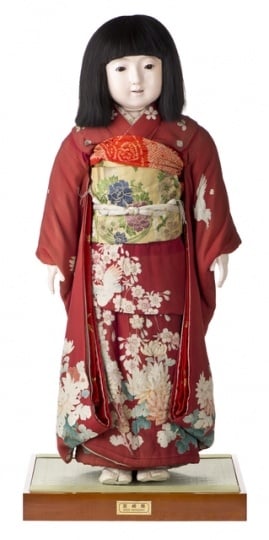
Miss Miyazaki doll
Miss Miyazaki (Tokushima) Japanese friendship doll made by Yoshitoku Doll Corporation, ca. 1927.
All rights reserved
Holding Location
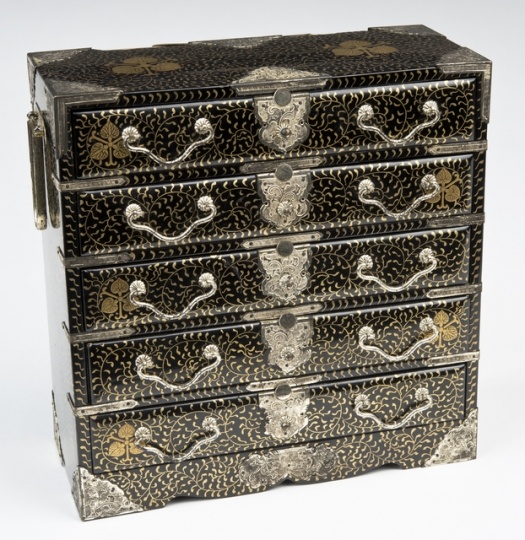
Doll bedding trunk
Doll bedding trunk with gold painted design and silver hardware. Part of the Miss Miyazaki Japanese friendship doll trousseau, ca. 1927.
All rights reserved
Holding Location
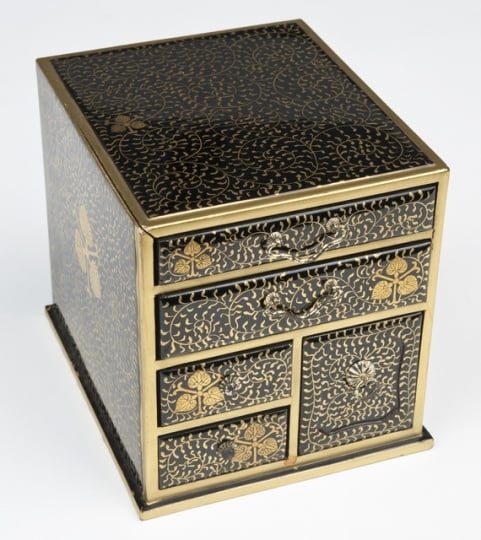
Chest of drawers for doll clothes
Black chest with five drawers for a doll with gold painted designs and silver hardware. Part of the Miss Miyazaki Japanese friendship doll trousseau, ca. 1927.
All rights reserved
Holding Location
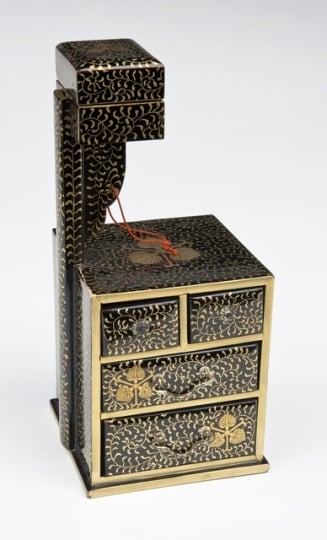
Sewing chest for a doll
Doll-sized sewing chest with four drawers, pin cushion, gold-painted design, and silver hardware. Part of the Miss Miyazaki Japanese friendship doll trousseau, ca. 1927.
All rights reserved
Holding Location
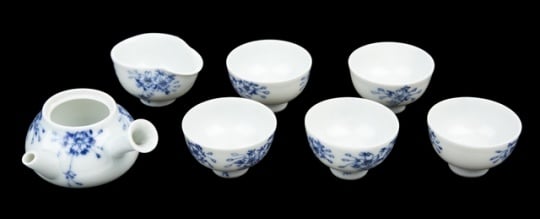
Tea set for a doll
Blue-and-white Chinese tea set for a doll. Part of the Miss Miyazaki Japanese friendship doll trousseau, ca. 1927.
All rights reserved
Holding Location
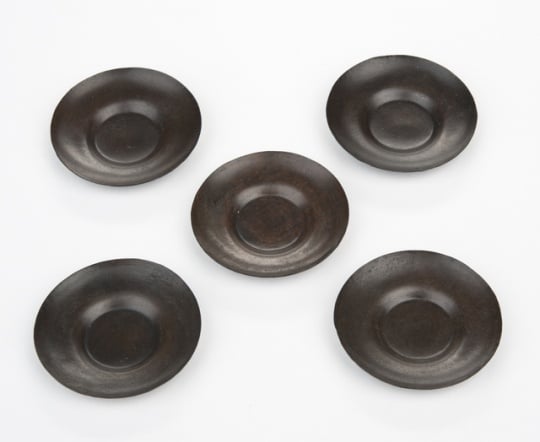
Tea-cup saucers for a doll
Chinese tea-cup saucers for a doll. Part of the Miss Miyazaki Japanese friendship doll trousseau, ca. 1927.
All rights reserved
Holding Location
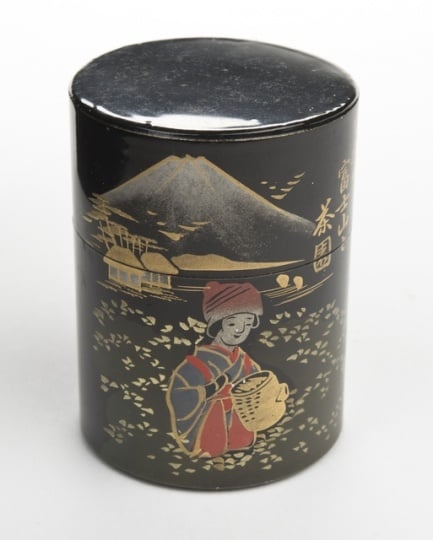
Loose-leaf tea container for a doll
Chinese loose-leaf tea container for a doll. Part of the Miss Miyazaki Japanese friendship doll trousseau, ca. 1927.
All rights reserved
Holding Location
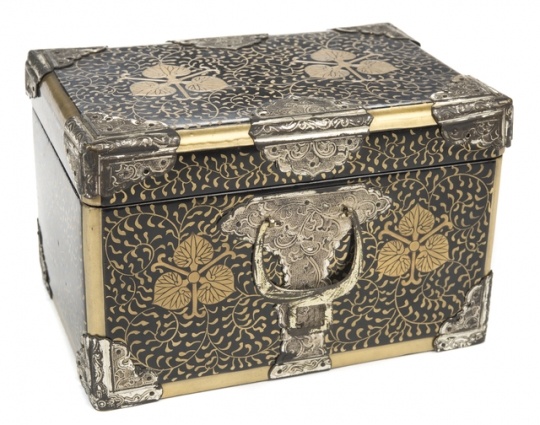
Doll trunk
Doll trunk with bottom drawer, gold-painted design, and silver hardware. Part of the Miss Miyazaki Japanese friendship doll trousseau, ca. 1927.
All rights reserved
Holding Location
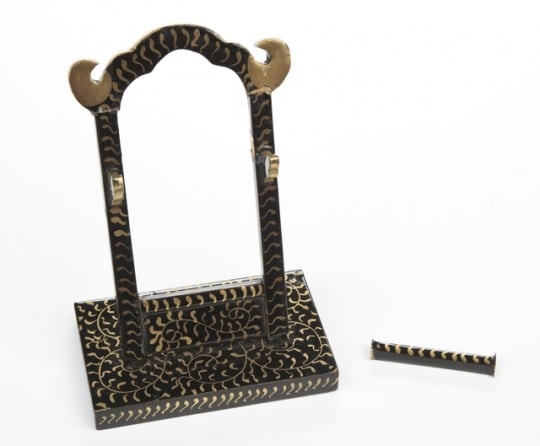
Mirror stand for a doll
Mirror stand with gold-painted designs for a doll. Part of the Miss Miyazaki Japanese friendship doll trousseau, ca. 1927.
All rights reserved
Holding Location
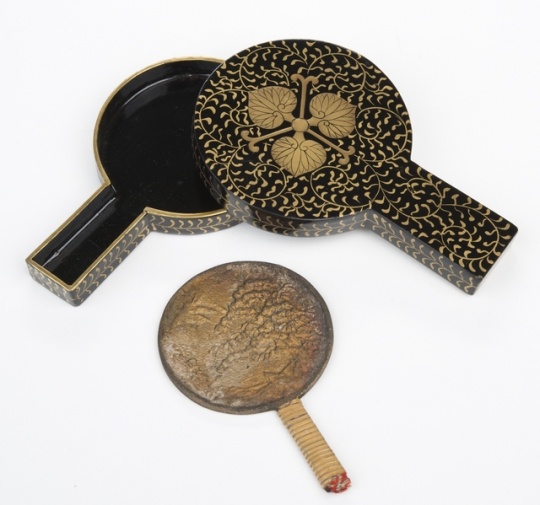
Mirror and case for a doll
Mirror in a black case with gold-painted design for a doll. Part of the Miss Miyazaki Japanese friendship doll trousseau, ca. 1927.
All rights reserved
Holding Location
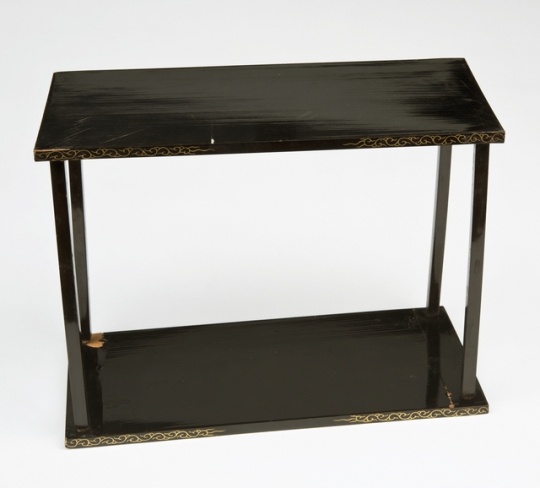
Formal shelf for a doll
Formal shelf with gold-painted design for a doll. Part of the Miss Miyazaki Japanese friendship doll trousseau, ca. 1927.
All rights reserved
Holding Location
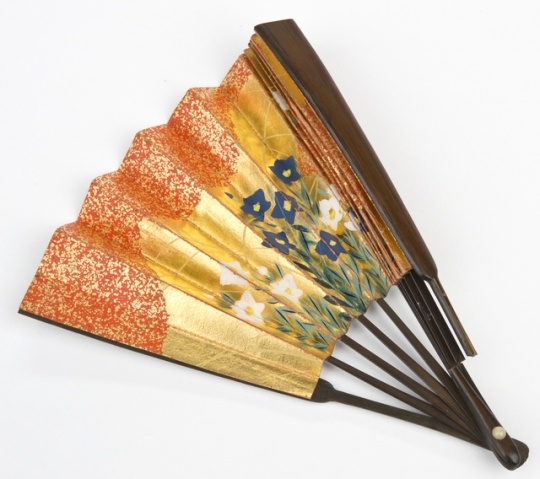
Miniature fan for a doll
Miniature fan for a doll. Part of the Miss Miyazaki Japanese friendship doll trousseau, ca. 1927.
All rights reserved
Holding Location
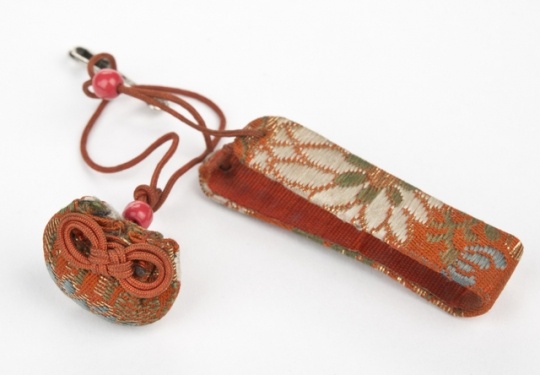
Wrist fastener for miniature doll fan
Wrist fastener for miniature doll fan. Part of the Miss Miyazaki Japanese friendship doll trousseau, ca. 1927.
All rights reserved
Holding Location
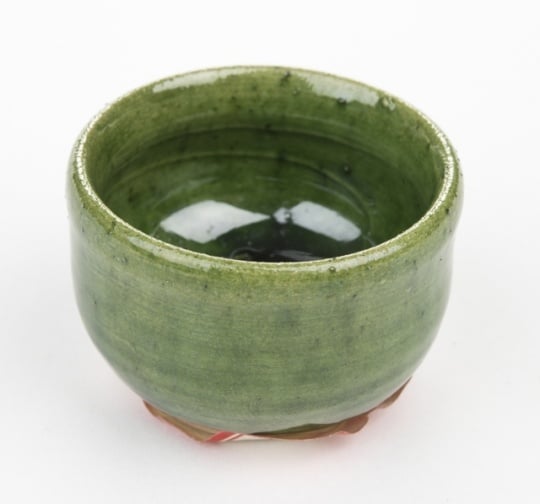
Miniature Japanese green tea prep bowl
Miniature Japanese green tea prep bowl. Part of the Miss Miyazaki Japanese friendship doll trousseau, ca. 1927.
All rights reserved
Holding Location
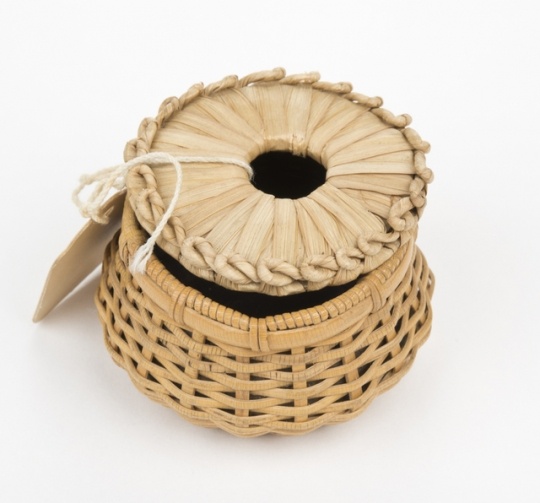
Grass hot pad and wicker basket for doll
Grass hot pad and wicker basket for doll. Part of the Miss Miyazaki Japanese friendship doll trousseau, ca. 1927.
All rights reserved
Holding Location
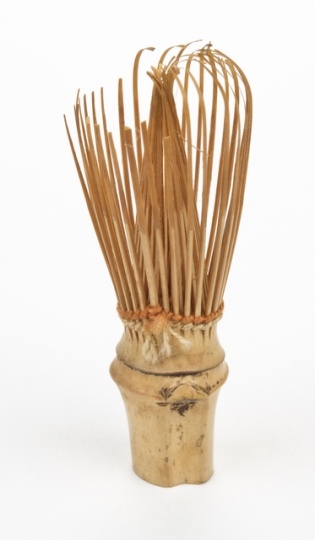
Japanese bamboo whisk for a doll
Japanese bamboo whisk for a doll. Part of the Miss Miyazaki Japanese friendship doll trousseau, ca. 1927.
All rights reserved
Holding Location
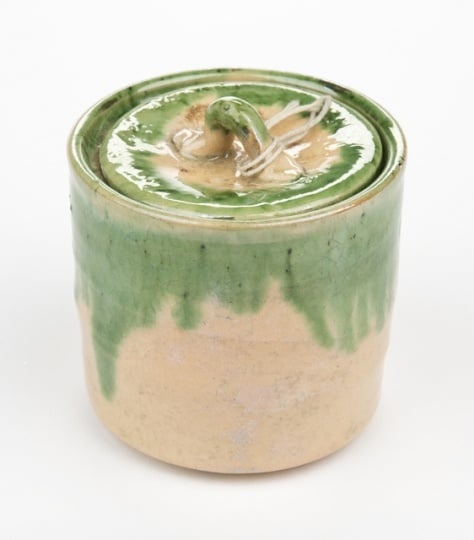
Miniature lidded water jar
Miniature lidded water jar for a doll. Part of the Miss Miyazaki Japanese friendship doll trousseau, ca. 1927.
All rights reserved
Holding Location
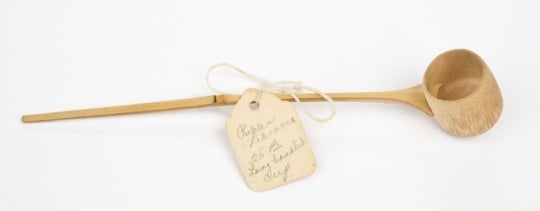
Miniature bamboo ladle
Miniature bamboo ladle for a doll. Part of the Miss Miyazaki Japanese friendship doll trousseau, ca. 1927.
All rights reserved
Holding Location
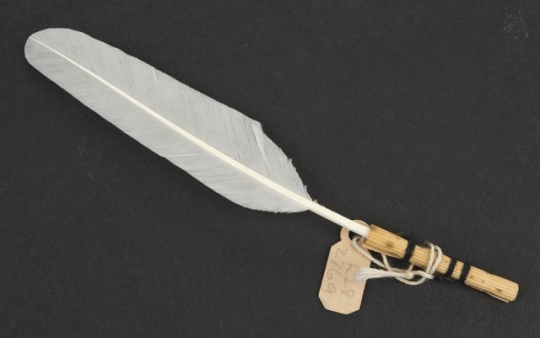
Feather for cleaning miniature tea set
Feather for cleaning miniature tea set. Part of the Miss Miyazaki Japanese friendship doll trousseau, ca. 1927.
All rights reserved
Holding Location
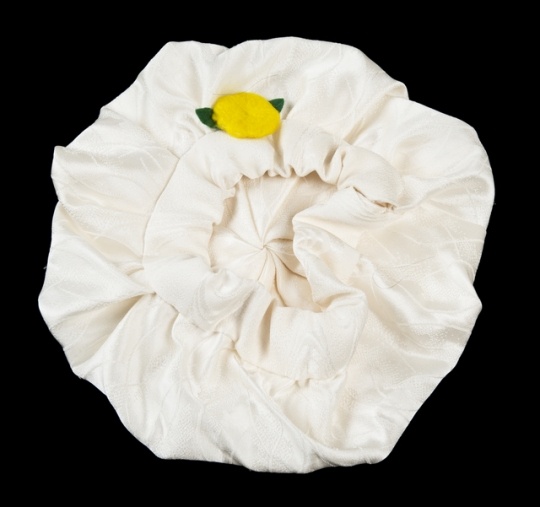
Miniature peace cap and felt flower for a doll
Miniature peace cap and felt flower for a doll. Part of the Miss Miyazaki Japanese friendship doll trousseau, ca. 1927.
All rights reserved
Holding Location
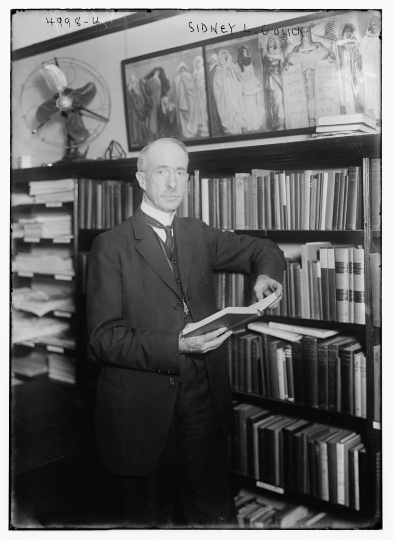
Dr. Sidney Lewis Gulick
Dr. Sidney Lewis Gulick, 1991. Photograph by Bain News Service; public domain.
Public domain
Holding Location
More Information
Related Articles
Turning Point
In 1926 Dr. Sidney Gulick establishes the Committee on World Friendship Among Children and begins to send dolls from America to Japan.
Chronology
early 1900s
1905
1919
1924
1926
1927
1931
1965
2016
2017
Bibliography
Pate, Alan Scott. "The Japanese Friendship Dolls of 1927 and the Birth of the Japanese Art Doll." Doll News, Winter 2013.
——— . Art as Ambassador: The Japanese Friendship Dolls of 1927. N.p.: Alan Scott Pate, 2016.
Related Resources
Primary
Fox 9 News. "Japanese Friendship Doll on Display at Minnesota History Center."
http://www.fox9.com/news/292065621-video
Minnesota Doll Jamboree. "Miss Miyazaki Update."
http://www.mndolljamboree.com/miss-miyazaki.html
Secondary
“Dr. Sidney Gulick, Missionary, Was 85.” New York Times, December 24, 1945.
http://ohsmemorial.com/OHS/articles/1879-gulick.htm
Guthrey, Molly. "She Arrived in 1927 and Then Disappeared. What Happened to Minnesota's Friendship Doll?" St. Paul Pioneer Press, November 5, 2017.
http://www.twincities.com/2017/11/05/she-arrived-in-1927-and-then-disappeared-what-happened-to-minnesotas-friendship-doll/
Web
Harvard University. The Pluralism Project: The Asiatic Exclusion League.
http://pluralism.org/document/the-asiatic-exclusion-league/
Hennepin County Libraries. Minneapolis Central Library.
https://www.hclib.org/about/locations/minneapolis-central






















